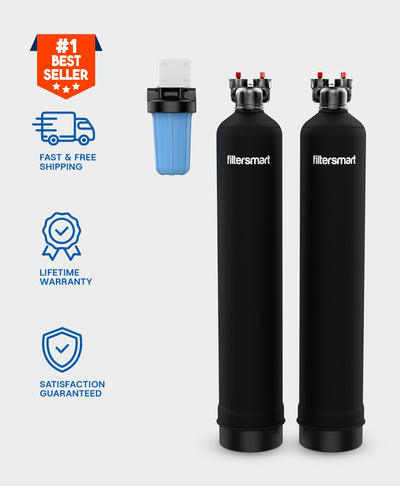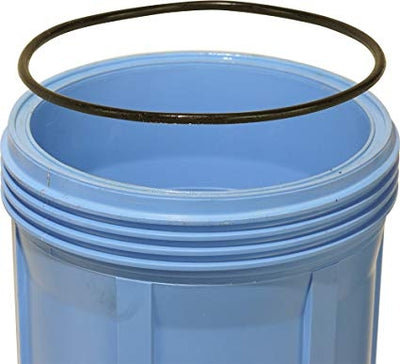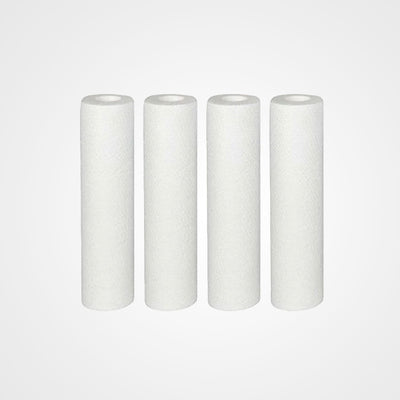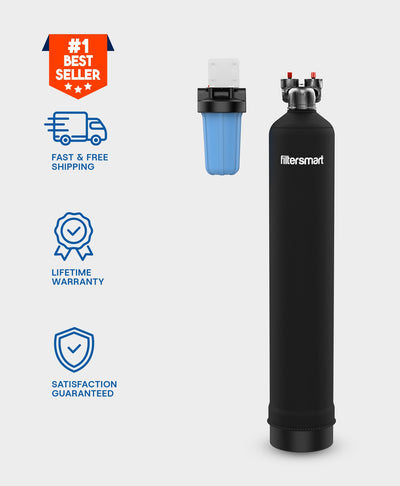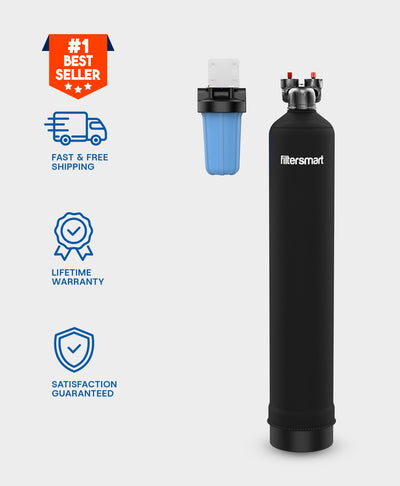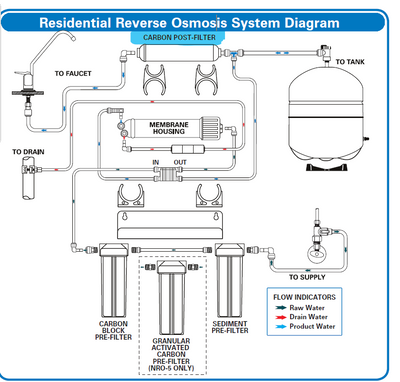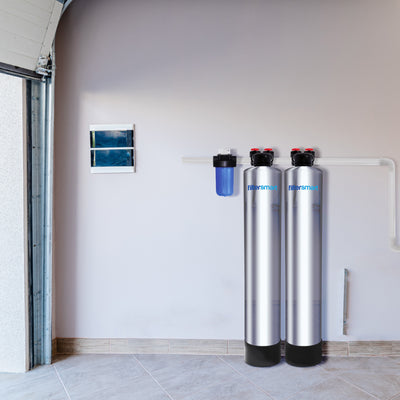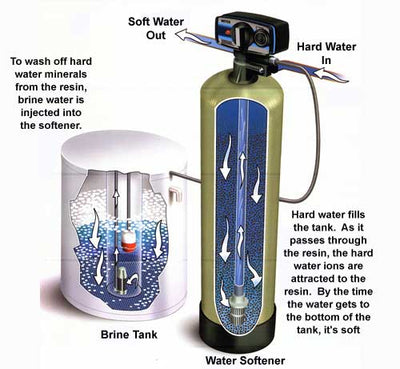Why would you want water softener alternatives?
Well, as we’ve written about before, traditional salt-based water softeners add a bunch of wastewater into the environment. Every time they regenerate, that’s water that 1) you can’t use and 2) ends up somewhere in the environment. And, as a result,municipalities are banning them all across the United States. When there’s a drought, no one wants to see anyone wasting water just for the sake of getting rid of some pesky limescale build-up.
Furthermore, you're probably getting tired of lugging around those 40lb bags of salt every few weeks or so. And you know where that extra sodium is going? Straight into your body, throwing off your sodium balance. By about an extra 300mg per day, on average, complicating you and your doctor’s attempts at decreasing your blood pressure.
In this article, we’ll show you exactly how you can soften water without a water softener. There are plenty of alternatives to salt-based ion exchange water softening. They essentially do the same things as a water softener (reduce limescale buildup) without ion exchange. Sometimes companies call them "conditioners" or "descalers."
So, without further ado, here are five water softener alternatives that actually work. First, though, here are some water softener alternatives that you should avoid. It might be tempting to purchase one of these systems because of the low price point. However, we’ll explain why you should probably stay away...

What Should You Avoid?
-
Electromagnetic Water Softeners
We’ve written in the past about the lack of research confirming the efficacy of electromagnetic water softeners. In short, while they might causesomeeffect, it probably isn’t enough to descale your water supply.
If you do end up buying an electromagnetic water softener and it doesn’t work, try testing the presence of an electromagnetic field with an app. Fun fact: iPhones and Androids already work as EMF detectors. Plenty of disgruntled buyers have done just that and found that, while therewasan electromagnetic field, there was no reduction in scale.
There’s just no point buying something that doesn’t work.
With that said, you should also probably avoid:
-
Chelation (Citric Acid Water Softeners)
According to theUniversity of Minnesota Water Resources Center, while citric acid water softening appears to be one of the cheapest water softener alternatives on the market, chelation hasn’t “been well proven, especially for higher hardness levels > 8-10 grains per gallon.” The University of Minnesota adds that chelation may not work if iron, dissolved oxygen, or dissolved silica are present.”
Until researchers confirm the efficacy of citric acid systems, it's probably best to stay away. While you won't spend a whole lot of money on an electromagnetic or citric acid water softener, you'll probably be throwing it away. It just isn’t worth it.
3 Water Softener Alternatives That Actually Work
-
Reverse Osmosis System
Reverse osmosis is a great way to get pristine, filtered water in your kitchen.
It can remove the following with ease: ions and metals like arsenic, fluoride, and sodium; organic chemicals like benzene; small particles like asbestos and protozoan cysts; and, finally, pesticides.
However, there are some drawbacks to reverse osmosis. Reverse osmosis can't remove dissolved gases like hydrogen sulfide. Hydrogen sulfide is responsible for giving your water a rotten egg smell (and flavor).
-
Potassium Chloride (Still Ion Exchange, Unfortunately)
This isn’t so much a water softener alternative as it is a sodium alternative. But, instead of using sodium in your water softener, you could buy potassium chloride. It’s a great way to treat hard water without salt (well, sodium chloride). This is unfortunately, however, still an ion exchange system -- even though salesmen might like to make you think otherwise.
The cost, in some cases, is as much as double, but you’ll get many benefits that you wouldn’t otherwise get from using sodium. The American Heart Association recommends no more than 2,300mg of sodium per day, and the average American consumes roughly 3,400mg per day. By using potassium instead of sodium in your water softener, you’ll cut back on that number.
However, potassium chloride water softeners, just like salt based water softeners, still might be banned in your area. They still need to undergo the regeneration process, which means they still produce a lot of wastewater.
-
Nucleation Assisted Crystallization (Template Assisted Crystallization) -- FilterSmart
Finally, as one of the best -- if notthebest -- water softener alternatives, we have template assisted crystallization.
According to the same report from theUniversity of Minnesota Water Resource Center we mentioned earlier, template assisted crystallization is as inexpensive as both electromagnetic and citric acid water softeners except it actually “prevents up to 90% scale build-up”.
The only drawback to template assisted crystallization water softeners is that you’ll have to purchase new replacement media once every three years or so. That still beats buying those 40lb bags of salt every other week, which will definitely cost more in the long run.
If you’re in the market for an alternative to your traditional salt-based ion exchange water softener, you couldn’t do much better than a FilterSmart template assisted crystallization system.
What is the Best Alternative to a Salt-based Ion Exchange Water Softener?
When you begin your search for water softener alternatives, you might stumble upon electromagnetic and/or citric acid water conditioners. Unfortunately, while these systems might seem incredibly promising at first, there’s actually very little data that suggests they’re effective. That’s particularly true if you live in an area of the United States that has severe hard water problems. Reducing scale build-up by 30% might not be enough -- and it’s certainly not worth the $300-$600 you had to spend on the system.
You could also look into reverse osmosis, although a whole-house reverse osmosis system is going to be very expensive, and it has its drawbacks as well. Reverse osmosis is very effective at dealing with 99% of dissolved solids, but it isn’t effective at reducing the presence of dissolved gases, like hydrogen sulfide. That’s why your water has that rotten egg odor.
By far the best and cheapest way to actually sidestep an ion exchange water softener (besides switching to potassium chloride, which is just going to be more expensive) is to purchase a template assisted crystallization water conditioner like those offered here at FilterSmart.
There are numerous studies confirming the efficacy of template assisted crystallization, making it one of the best domestic alternatives to ion exchange water softening.
Questions? Concerns? Feel free to get in touch:
Call us: 866.455.9989
Email us: sales@filtersmart.com







